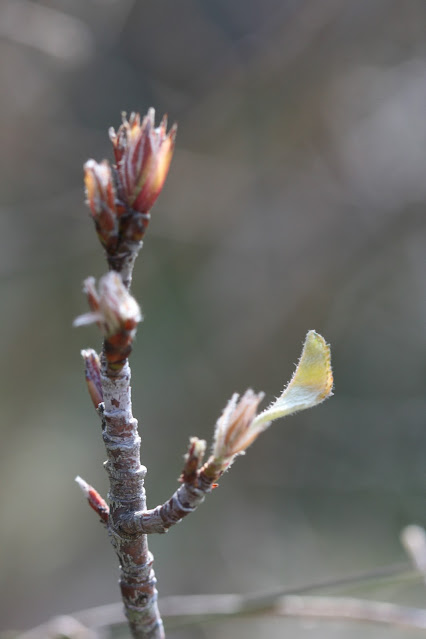Spring 2022 - Don't be A Zonist
 |
| Downy Serviceberry - Amelanchier arborea |
 |
| Littlehip haw - Crataegus spathulata |
 |
| Flatwoods plum - Prunus umbellata |
The small deciduous woodland that I planted soon after arriving here in my new (rental) home in Holiday is entering its fourth spring and it is maturing nicely. It contains most of my favorite woody trees and shrubs - virtually all deciduous, and a great many that are not native to my "zone". I am vehemently opposed to planting zones as a determinant to what to plant. Planting zones were established solely for giving guidance to fruit and vegetable gardeners as to when the last frost was likely to occur. It was about such things as "don't plant your tomatoes in central MN until after this date because they might freeze." It was NEVER about determining what species of plant you could successfully grow in your landscape. It truly makes NO difference to your planting palette unless you are using frost-sensitive native species north of their tolerance to cold.
Diehard zonists would have you believe otherwise and some native plant purists would join in; those that would argue that a plant is not native in your landscape if it is not naturally native to your county or within 50 miles of it. I've argued against such thinking now for more than 30 years, but I understand that it will persist regardless. I'm just proud to say that I've never been bound to their way of thinking.
My landscape (and the one before it) is the poster child for my way of thinking. Nearly every plant in my woodland, for example, is not native to Pasco County or an area within 50 miles from here. These plants prosper here, they flower and set fruit, they are ecologically significant, and they bring me joy - all the requisites of a good landscape addition. They were not selected for their beauty alone, but they are beautiful. Now, with a few years more under their "belts", they are contributing the ecological values they were intended to impart.
Some would argue that my downy serviceberry is inappropriate because it occurs naturally in the central and western panhandle, hundreds of miles from here. Despite the fact that this is true regarding its range, my 2 trees have grown well, flowered and set fruit. From the looks of it, they will do that even more in the weeks ahead. I do not water or fertilize my plants and I've never resorted to using a pesticide to keep them healthy. .I don't see the issue associated with their nativity.
My littlehip haws are setting flowers for the first time ever. They have an even smaller natural range in Florida than the serviceberries. I grew these from seed as I am not aware of them ever being propagated by a licensed native plant nursery in Florida. My two plants are 7-8 years old now from seed, and finally mature enough to flower and bear fruit. The flowers they will produce are quite attractive to pollinators and the tiny red fruit are exceedingly attractive to songbirds in the winter. It is a tree that should be widely propagated, but haw seeds generally take two years to germinate and that seems to limit the excitement of nursery folks of adding them to their offerings.
I purchased the flatwoods plum as a 3-gallon specimen at a local native plant sale during the first spring after moving here. It did not bloom that spring or the following one and it set only a few flowers last year. This year, however, every branch is bursting with flower buds and it should be spectacular. Flatwoods plum is native to my region, but I chose it for its ecological and aesthetic attributes. Although the plums are too large for much of anything other than gray squirrels and crows, the flowers attract the attention of everything and the structure provides excellent cover for birds to hide and nest.
These are the early bloomers. Sadly, my red buckeye (Aesculus pavia) does not appear to have flower buds this year despite growing quite well. The other plants in my little woodland will bloom and leaf out a few weeks later. The cavalcade keeps my attention and it extends my spring for a month or so. We should plant for all of these reasons - ecological value, aesthetics, and joy. When we ignore the well intentions of the zonists, we can embrace whatever choices we make that might give us all of these qualities. Some plants that you would love won't be adapted to your site, but it is that alone that should shape your landscape decisions. You, in fact, have far more possibilities than you might be led to think. Embrace that freedom and don't be afraid to go "out on a limb."



Comments
Post a Comment